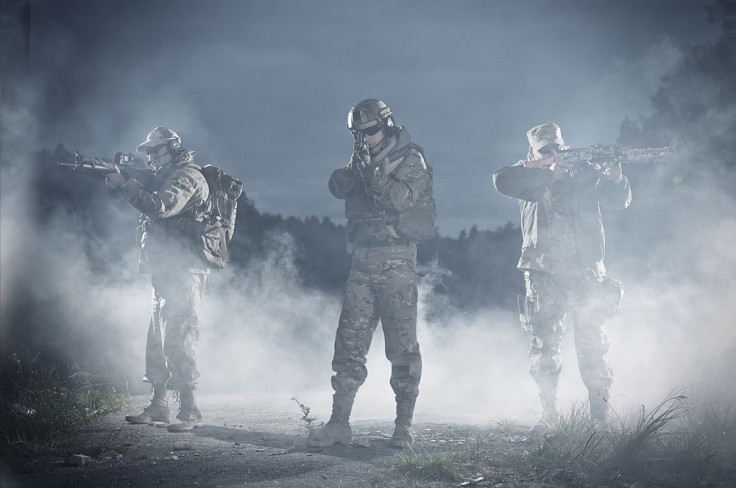Dwindling US Troop Numbers In Europe Leaves NATO In A Quandary

Russia's incursion in Ukraine has breathed new life into an old debate -- how much Europe should depend on the U.S. military for protection. On Wednesday, a NATO spokesperson said the organization's European members must spend more money on defending their borders and rely less on the U.S.
Constant Brand, the NATO spokesperson, noted in an email to International Business Times that during the last five years Russia has increased its defense investment by 50 percent, "while NATO allies in the same period have decreased its defence spending by 20 percent in average [and], some allies cut their defence budget by up to 40 percent. This is not sustainable."
Brand's comment amplified a statement made by the organization's head on Monday, which followed an announcement by the head of the United States European command, Air Force Gen. Philip Breedlove, that current U.S. troop levels in Europe are insufficient to deal with the crisis created by Russia.
Anders Fogh Rasmussen, the general secretary of NATO, on Monday told the Atlantic Council of the United States that NATO's 28 member countries should spend at least 2 percent of their GDP on defense -- something that only the U.S., United Kingdom, Greece and Estonia have achieved, though Turkey, Poland, Romania, Latvia and Lithuania have promised to reach that level by 2020.
“I am not the first to say that some European nations can and should do more,” Rasmussen said, echoing the May 2014 comments of U.S. Secretary of Defense Chuck Hagel . “NATO is an insurance policy against instability. All members must pay their premiums, and that premium has just gone up.”
The push for NATO member states to spend more has become increasingly urgent after the U.S., which spends more than all other NATO members combined, announced plans to reduce its military spending from 4.6 percent in 2011 to 2.9 percent in 2017. The decrease is considered particularly crucial in Europe following Russia's invasion of Crimea in February 2014. The proposed cuts will reduce U.S. troop numbers in Europe (which includes 10,000 Africa-based troops) from the current level of 67,000 to around 57,000 over the next five years.
Ilan Berman, vice president at the American Foreign Policy Council, told IBTimes the U.S. drawdown means that Europe has to put “its money where its mouth is” and assist the U.S. more in defending its borders. “Having European allies carry more of the water, or a greater percentage of the water, for NATO is, I think, huge,” Berman said. “The reality is, NATO is only as strong as its weakest members, so what you had consistently over the last decade is a post-military Europe, a Europe’s that is transitioning away from defense issues to more focus on peacekeeping, what have you, and that has impacted the credibility of NATO.”
After Russian troops withdrew from the Ukrainian border in May, tensions with the West appeared to ease. However, in early June, U.S. officials said that several thousand troops had returned to the border region, and pro-Russian fighters remain hostile in the eastern part of the country.
While the Department of Defense has reacted to the threat of Russia by arranging for a rotational force to be stationed in Europe for six months starting in October this year, temporarily bolstering the overall troop figures by a few thousand, Breedlove said he was concerned about long-term troop reductions.
“I think that, first and foremost, we should now pause and determine: Should we continue with any of the program reductions that are in the plan for Europe?” Gen. Breedlove said in statement on June 30. “As a result of budget and sequester, there are already some reductions that are still on the books. So I think the first step in this process is that we develop a mechanism by which we stop [and] re-look [at] those planned actions for Europe.”
Berman said Breedlove's remarks were likely intended to send a message to the Kremlin, but that they address a bigger issue than Ukraine. “His point seems to be that the challenge Russia pose[s] in the Ukraine isn’t just about Ukraine,” Berman said. “It’s about all of Europe and whatever we do, all of the particulars, a U.S. force drawdown may see Russia getting the wrong idea. The Eastern European states are vulnerable, fragile and undefended, so his point is certainly to try and inject some doubt into the Kremlin’s calculus.”
In Berman's view, Russia’s venture into Europe is part of a long-term strategy, one part of which became evident in 2008, when Russian forces marched into Georgia. “The long-term exercise is to expand Russia’s border," Berman said. “Crimea is a bitesize chunk that Russia took and now needs to digest before it moves on. Now the U.S. and Europe have time to counter that.”
The Department of Defense confirmed in a statement to IBTimes that there is no plan to increase troop figures in the current defense budget for European operations. “The President's fiscal year 2015 Overseas Contingency Operations budget proposal was submitted to Congress on June 26th,” read the statement. “It included a $1 billion proposal called the European Reassurance Initiative (ERI). The ERI would provide temporary support to bolster the security and capacity of our NATO allies and partner states in Europe.”
© Copyright IBTimes 2025. All rights reserved.






















